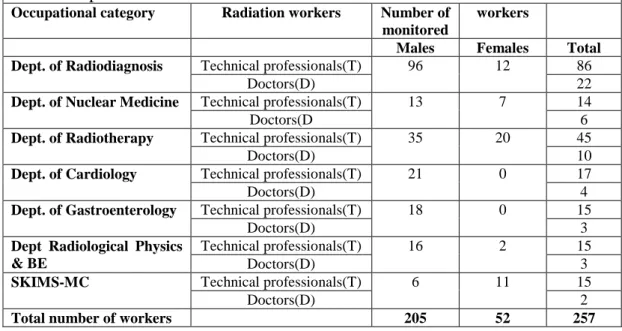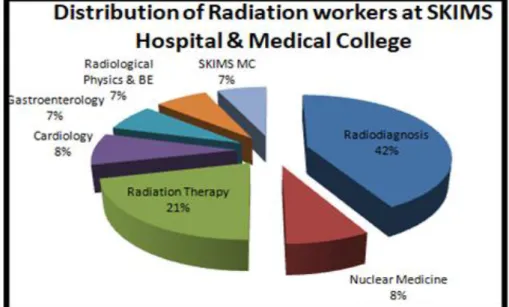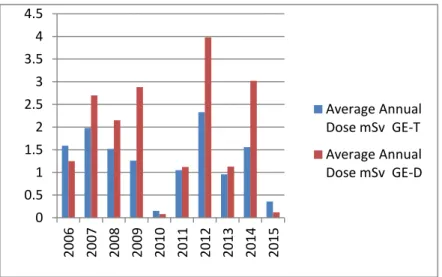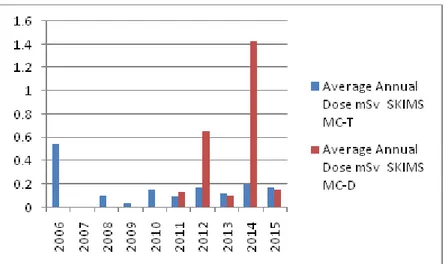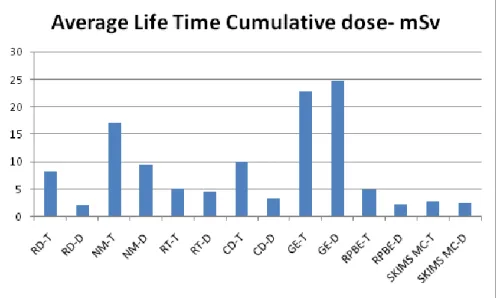M. Mohib-ul Haq et al JMSCR Volume 07 Issue 03 March 2019 Page 1511
Research Article
Occupational radiation dose for medical workers in a tertiary care
hospital-A ten year evaluation
Authors
M. Mohib-ul Haq, Misbah H Baba, Aijaz A Khan, Mohsin R Khan, Sajad A Rather
Department of Radiological Physics and Bio-Engineering, Sher-i- Kashmir Institute of Medical Sciences, Soura, Srinagar, Kashmir, India —190 011
*Corresponding Author
Aijaz A Khan
Email: khanaijaz2000@gmail.com
Abstract
Occupational radiation doses for medical workers from the departments of diagnostic radiology, nuclear medicine, radiotherapy, cardiology, gastroenterology, radiological physics & BE and associated medical college of Sher I Kashmir Institute of Medical Sciences (SKIMS) Hospital were measured and analyzed. A total of 257 medical radiation workers were monitored to determine the status of their average annual effective dose and average cumulative life time dose. The analysis of this study was carried out at the Radiation Safety Lab of the Department of Radiological Physics & BE, at SKIMS. The monitored workers were classified into subgroups namely technical professionals and doctors, according to their clinical responsibilities and specialties. The whole body doses were measured using thermo luminescence dosimeters developed in Bhabha Atomic Research Centre (TLD-BARC (CaSo4:Dy)) worn at the chest level in all types of
workers except for those in the cardiology lab and gastroentrology, for whom the TLD was worn under the lead apron(0.5millimeter lead thickness). In addition the three departments viz nuclear medicine, cardiology and gastroenterology department were provided with an extremity dosimeter. The annual average effective doses for radiodiagnosis, nuclear medicine, radiotherapy, cardiology, gastroenterology, radiological physics & BE & SKIMS Medical college, workers were found to be,0.26, 0.60, 0.18, 0.35, 1.37, 0.17 and 0.25 mSv, respectively. The department of Nuclear Medicine using the unsealed radioisotopes was recorded for the hand/extremity dose as well and the average dose was 1.06mSv. The departments using fluoroscopic guided procedures viz cardiology and gastroenterology using fluoroscopic guidance for various procedures were also provided with the additional extremity dosimeter and the average doses were found 0.42 and 5.57 mSv respectively. The results of the measured annual dose were well below the international recommended occupational dose limit of 20 mSv.
The average life time cumulative doses for diagnostic radiology, nuclear medicine, radiotherapy, cardiology, gastroenterology, radiological physics & BE & SKIMS Medical college, workers were found to be, 7.10, 14.91, 4.97, 8.79, 23.12, 4.28 and 2.82mSv, respectively.
Keywords: Annual effective dose, Thermo luminiscent dosimeter, radiation, mSv-millisievert, Hp(10), Hp(0.07).
www.jmscr.igmpublication.org Index Copernicus Value: 79.54
ISSN (e)-2347-176x ISSN (p) 2455-0450
M. Mohib-ul Haq et al JMSCR Volume 07 Issue 03 March 2019 Page 1512
Introduction
Radioisotopes have been used in many applications, such as medicine, research, education, industry, and agriculture, for a wide range of purposes beneficial to human populations. The health services are being improvised day by day with the advancements in technical knowhow and improvised machinery and that has resulted in an increased use of radionuclide’s and radiation in diagnosis and therapy[1]. All occupational exposures to ionizing radiation represent the major part of man-made exposure to low radiation doses to the personnel involved. It is estimated that cancer risk incidence directly increases with the absorbed dose and it is important to determine the deterministic and stochastic effects from this low radiation dose[2]. The various international regulatory bodies aim to regulate and provide a system with useful standards for radiation protection including medical, occupational, environmental, and exposure controls against radiological accidents without unduly limiting the beneficial practices giving rise to radiation exposure. The important one being the International Commission on Radiological Protection (ICRP)[3,4]. It defines the term “occupational exposures” which refers to the exposure of people at work to ionizing radiation from natural and man-made sources as a result of operations within a workplace,[5-12]. It is recommended for workers exposed to medical radiation sources to strictly follow and practice all the regulatory requirements established in the International Basic Safety Standards for Protection against Ionizing Radiation and the Safety of Radiation Sources, here in India to follow the Atomic Energy Act of 1962 (33 of 1962) and Atomic Energy Radiation Protection Rules-2004. Dose estimation for radiation workers is an important factor for government and Atomic Energy Regulatory Board (AERB) to evaluate radiation risks and establish protective measures strictly to be followed in medical use of Ionizing radiation [13]. All occupational workers must be consequently subjected to routine monitoring of
M. Mohib-ul Haq et al JMSCR Volume 07 Issue 03 March 2019 Page 1513 Medical College (SKIMS Medical college) —
during a ten year period from 2006 to 2015 to track these departments for the occupational radiation dose to determine the highest exposure area and to check the radiation protection standards met out at these departments.
Materials and Methods
In this study, thermo luminescent dosimeters (TLD) were used. The TLDs consist of cards with appropriate filter holders containing a detector crystal of Calcium sulphate doped with dysprosium -CaSO4:Dy to provide measurements
of skin and deep doses. Of the thermo luminescence phosphors, dysprosium doped calcium sulphate is one of the most efficient and cheap phosphors for the use in radiation dosimetry [25, 26]. It was made sure that the workers wore the badge in proper places during their work. The upper side of the chest is the most important area to wear the dosimeter as recommended by ICRP. The calibration process was totally automated from Ultratech Lab Pvt Ltd. Both the whole-body dose (effective dose in milli Sievert-mSv) Hp (10) and the skin dose-extremity (equivalent dose in milli Sievert-mSv) Hp (0.07) for the period from 2006 to 2015 were taken from the radiation safety labs data base from SKIMS. The International Commission on Radiological Units and Measurements[24] recommends whole-body doses in terms of the personal dose equivalent, Hp (10). TLDs worn by occupational medical personnel’s were evaluated by the company itself for personnel dose equivalents. It is important to mention that a single TLD badge was recommended for occupational workers in radiodiagnosis, radiotherapy, radiological physics & BE & Sher-I-Kashmir Institute of Medical Sciences Medical College (SKIMS Medical college) and two TLD dosimeters for nuclear medicine, cardiology and gastroenterology-one for whole body and another for extremity to measure dose to skin Hp(0.07).
Results and Discussion
Distribution of medical radiation workers
The dose distributions of radiation workers are used to determine the minimum level of exposure in the medical field according to as low as reasonably achievable -ALARA principles. In the SKIMS H&MC, approximately 257 occupational radiation workers were monitored. The percentage distribution of the occupational medical radiation personnel’s in the seven medical departments of SKIMS Hospital & MC were Radio-diagnosis (42%), Nuclear Medicine (8%), Radiotherapy (21%), Cardiology (8%), Gastroenterology (7%), Radiological Physics & BE (7%), & SKIMS Medical college (7%), —during the period from 2006 to 2015. Table 1 shows the number of radiation workers monitored (male and female) in all occupational categories of medical departments and their position during 2006-2015. Figure 1 shows the percentage wise contribution from each type of medical radiation worker to the total monitored workers.
Occupational doses at the department of radiodiagnosis
M. Mohib-ul Haq et al JMSCR Volume 07 Issue 03 March 2019 Page 1514 which represents 8% of the annual recommended
dose limit.
Occupational doses at the department of nuclear medicine
Again from Table 2 the average annual effective dose for the department of nuclear medicine ranged from 0.19 mSv to 2.11mSv, with an average value of 0.57 mSv for technical professionals and 0.2 mSv to 1.94 mSv, with an average value of 0.65 mSv for doctors in the department. The annual effective dose distribution for all radiation workers in the nuclear medicine department is shown in Figure 3. An additional wrist TLD Badge was provided to the staff in this department due to the use of unsealed radioisotopes. The average wrist dose was found to be ranging between 0.6 to 1.70mSv with an average of 1.06mSv, Fig 12. From these values it can be concluded that the measured doses were well below the dose limit. In general, it was noted that the nuclear medicine technicians received relatively higher values for their chest absorbed dose (>2 mSv) than did the nuclear medicine doctors due to their main job and responsibilities to carry out the examinations using unsealed radioisotopes for diagnostic and therapeutic applications according to the set protocol of the department.
Occupational doses at the department of radiotherapy
Table 2 shows that the average annual effective dose ranged from 0.06 mSv to 0.33mSv, with an average value of 0.18 mSv for technical professionals and 0.03mSv to 1.27 mSv, with an average value of 0.20 mSv for doctors in the department of radiotherapy. The annual effective dose distribution for all radiation workers in the radiology department is shown in Figure 4.These values were well below the recommended dose limit.
Occupational doses at the department of cardiology
The occupational radiation doses for medical staff using fluoroscopic procedures is usually on a higher side[3]. Cardiology is the most dynamic field in terms of medical exposure due to the application of diagnostic X-rays. Workers in the cardiology field have a high effective dose, and in addition, the extremity and eye lens dose can reach the recommended regulatory limit[5]. Table 5 shows that while the annual occupational dose to a technical professional ranged from 0.03 mSv to 1.42 mSv with an average value of 0.44 mSv, the corresponding value for a cardiology laboratory doctors ranged from 0.00 mSv to 1.04 mSv with an average value of 0.26 mSv. An additional wrist TLD Badge was provided to the staff in this department as the use of fluoroscope predominates here too. The average wrist dose was found to be ranging between 0.17 to 0.75mSv with an average of 0.42mSv, Fig 12.From the results in Table 5, we can conclude that the workers in a cardiology laboratory are exposed to a relatively higher amount of radiation than those doing CT scans radiology dept. The annual effective dose distribution for all radiation workers in the cardiology is shown in Figure 5.This received dose still remains well below the recommended dose limit.
Occupational doses at the department of endoscopy-gastroenterology
M. Mohib-ul Haq et al JMSCR Volume 07 Issue 03 March 2019 Page 1515 An additional wrist TLD Badge was provided to
the staff in this department as the use of fluoroscope predominates here too. The average wrist dose was found to be ranging between .09 to 11.54mSv with an average of 5.57mSv, Figure 12. Based on the results of the annual dose in every department, a close correlation between the received doses and the job position was observed.
Occupational doses at the department of Radiological Physics & BE
Table 2 shows the distribution of the annual dose for different specialists among the workers in the RPBE department. This department has the responsibility of maintaining the radiation safety at the hospital level. The Radiation Safety Officer along with the Qualified Medical Physicists ensure the radiation safety in all dimensions with regard to the safety of occupational workers, patient and general public, these act like a mini competent authority at a hospital level. The average annual effective dose ranged between 0.1 and 0.43 mSv, with an average value of 0.19 mSv for technical professionals and 0.0mSv to 0.28mSv, with an average value of 0.01 mSv for the doctors. The annual effective dose distribution for all radiation workers in the RPBE department is shown in Figure 7.
Occupational doses at the department of SKIMS MC
Table 2 shows the distribution of the annual dose for different specialists among the workers in the Dept of SKMC, i.e. Radiology and Orthopedics.
These departments too used CT Scanners, X-Rays and Fluoroscopes, therefore the doses here too are little on a higher side. The average annual effective dose ranged between 0.0 and 0.19 mSv, with an average value of 0.15 mSv for technical professionals and 0.0mSv to 1.43mSv, with an average value of 0.25 mSv for the doctors. The annual effective dose distribution for all radiation workers in the SKMC radiology and orthopedics department is shown in Figure 8.
M. Mohib-ul Haq et al JMSCR Volume 07 Issue 03 March 2019 Page 1516
Table 1 Number of radiation workers monitored in all occupational categories of medical departments.
Occupational category Radiation workers Number of
monitored
workers
Males Females Total
Dept. of Radiodiagnosis Technical professionals(T) 96 12 86
Doctors(D) 22
Dept. of Nuclear Medicine Technical professionals(T) 13 7 14
Doctors(D 6
Dept. of Radiotherapy Technical professionals(T) 35 20 45
Doctors(D) 10
Dept. of Cardiology Technical professionals(T) 21 0 17
Doctors(D) 4
Dept. of Gastroenterology Technical professionals(T) 18 0 15
Doctors(D) 3
Dept Radiological Physics & BE
Technical professionals(T) 16 2 15
Doctors(D) 3
SKIMS-MC Technical professionals(T) 6 11 15
Doctors(D) 2
Total number of workers 205 52 257
Table 2 Departmental distribution of average annual dose
Department
Total number of
workers
Working group Dose range
mSv
10 years Average Annual dose
(mSv)
Dept. of Radiodiagnosis 108
Technical professionals(T)
(0.01-0.86) 0.27
Doctors(D) (0.01-1.60) 0.2
Dept. of Nuclear Medicine 20
Technical professionals(T)
(0.19-2.11) 0.57
Doctors(D) (0.2-1.94) 0.65
Dept. of Radiotherapy 55
Technical professionals(T)
(0.06-0.33) 0.18
Doctors(D) (0.03-1.27) 0.2
Dept. of Cardiology 21
Technical professionals(T)
(0.03-1.42) 0.44
Doctors(D) (0.00-1.04) 0.26
Dept. of Gastroenterology 18
Technical professionals(T)
(0.15-2.33) 1.28
Doctors(D) (0.08-3.98) 1.84
Dept. of Radiological Physics & BE 18
Technical professionals(T)
(0.1-0.43) 0.19
Doctors(D) (0.01-0.28) 0.1
Dept. of SKIMS-MC 17
Technical professionals(T)
(0.00-0.19) 0.15
M. Mohib-ul Haq et al JMSCR Volume 07 Issue 03 March 2019 Page 1517 0
0.5 1 1.5 2 2.5
2006 2007 2008 2009 2010 2011 2012 2013 2014 2015
Average Annual Dose mSv NM-T
Average Annual Dose mSv NM-D
Figure 1 Department wise Percentage distribution of radiation workers at SKIMS Hospital and Medical College
Figure 2 Average annual dose for all radiodiagnosis -RD (technical professionals T, doctors D) occupational workers for a period of ten years 2006-2015
M. Mohib-ul Haq et al JMSCR Volume 07 Issue 03 March 2019 Page 1518 0
0.2 0.4 0.6 0.8 1 1.2 1.4
2006 2007 2008 2009 2010 2011 2012 2013 2014 2015
Average Annual Dose mSv RT-T
Average Annual Dose mSv RT-D
0 0.2 0.4 0.6 0.8 1 1.2 1.4 1.6
2006 2007 2008 2009 2010 2011 2012 2013 2014 2015
Average Annual Dose mSv Cardiology-T
Average Annual Dose mSv Cardiology D
0 0.5 1 1.5 2 2.5 3 3.5 4 4.5
2006 2007 2008 2009 2010 2011 2012 2013 2014 2015
Average Annual Dose mSv GE-T
Average Annual Dose mSv GE-D
Figure 4 Average annual doses for all Radiotherapy -RT (technical professionals T, doctors D) occupational workers for a period of ten years 2006-2015
Figure 5 Average annual doses for all Cardiology -CD (technical professionals T, doctors D) occupational workers for a period of ten years 2006-2015
M. Mohib-ul Haq et al JMSCR Volume 07 Issue 03 March 2019 Page 1519
Figure 7 Average annual dose for all Radiological Physics & BE-RPBE (technical professionals T, doctors D) occupational workers for a period of ten years 2006-2015
Figure 8 Average annual dose for all SKIMS Medical College-SKMC (technical professionals T, doctors D) occupational workers for a period of ten years 2006-2015
M. Mohib-ul Haq et al JMSCR Volume 07 Issue 03 March 2019 Page 1520
Figure 10 Average Life Time Cumulative Dose to the subgroups -technical professionals and doctors in the seven departments at SKIMS H &MC
Figure 11 Average Life Time Cumulative Dose in mSv in the seven departments at SKIMS H &MC
M. Mohib-ul Haq et al JMSCR Volume 07 Issue 03 March 2019 Page 1521
Conclusion
The measured annual effective doses for occupational radiation workers at seven different medical departments received was well below the recommended dose limit (20 mSv). The doses to the workers of radio diagnosis, nuclear medicine, radiotherapy, cardiology lab, gastroenterology, radiological physics & BE & SKIMS Medical college, workers was 0.26, 0.60, 0.18, 0.35, 1.37, 0.17 and 0.25 mSv, respectively which is many times (93%) lesser than the stipulated limits set by the national and international regulatory authorities. Thus the radiation protection programme to limit the low dose radiation exposure carried out at SKIMS Hospital & Medical College is much effective and is a direct outcome of the strict adherence to these national and international protocols.
References
1. S. Balwinder, S. Jaspreet, K. Amritpa, Applications of Radioiso- topes in Agriculture, Int J Biotechnology and Bioengineering Research 4 (3) (2013) 167–174.
2. Effect of ionizing radiation. United Nations Scientific Committee on the Effects of Atomic Radiation (UNSCEAR), United Nations, New York, 2006 (1). 3. Report 60 Recommendations of the
International Commission on Radiological Protection. International Commission on Radiolog- ical Protection (ICRP), 1990, Publ 60, Ann ICRP 21 (1-3).
4. L. Dariusz, The Grand Challenge: use of a new approach in devel- oping policies in the area of radiation and health, Frontiers in Public Health: Radiation & Health jouranal 2 (50) (2014) 1–4.
5. W. Weizhang, W. Zhang, R. Cheng, L. Zhang, Occupational Exposures of Chinese Medical Radiation Workers in 1986-2000, Radiation Protection Dosimetry 117 (4) (2005) 440–443.
6. T. Yuan, Z. Liang, J. Yongjian, Dose level of occupational expo- sure in China, Radiation Protection Dosimetry 128 (4) (2008) 491–495.
7. M. Chales, Sources and effects of ionizing adiation, J. Radiol. Prot; 21 (1) (2001) 83– 86.
8. International basic safety standards for protection against ioniz- ing radiation and for the safety of radiation source, International Atomic Energy Agency (IAEA), 1996, Safety Series No 115. 9. Radiation, sources and effects of ionizing.
United Nations Scien- tific Committee on the Effect of Atomic Radiation (UNSCEAR), Volume I, United Nations Sales Publication, New York, 2000.
10.M. Khalid, A. Munir, Z. Junaid, H. Mumtaz, A. Afshan, Z. Haroon, Assessment of Occupational Exposure Among Pakistani Medical Staff During 2007-2011, Australas Phys. Eng. Sci. Med 35 (2012) 297–300.
11.A. Jabeen, M. Munir, A. Khalil, M. Masood, P. Akhter, Occu- pational Exposure from External Radiation used in Medical Practices in Pakistan by Film Badge Dosimetry, Radiation Pro- tection Dosimetry 140 (4) (2010) 396–401.
12.Occupational radiation protection: protecting workers against exposure to ionizing radiation. International Atomic Energy Agency (IAEA), in: Proceedings of an International Conference, Geneva, 26-30 August, 2002.
13.P. Mora, M. Acuna, Assessment of Medical Occupational Radi- ation Doses in Costa Rica, Radiation Protection Dosimetry 147 (1-2) (2011) 230–232. 14.R. Hendee, Estimation of radiation risks:
BEIR V and its signifi- cance for medicine, J Am. Med. Assoc. 268 (1992) 620–624.
M. Mohib-ul Haq et al JMSCR Volume 07 Issue 03 March 2019 Page 1522 hospitals: Global assessment, critical
applica- tions and future needs, Radiation Prot. Dosimetry 124 (3) (2007) 250–259. 16.M. AleksanDa, I. Sonja, S. Vesna, J.
Slobodan, A dose estima- tion for persons occupationally exposed to ionizing radiation in Montenegro 2008. (1-2) (2008) www.onk.ns.ac.yu/Archive.
17.R. Kopec, M. Budzanowski, A. Budzyniska, R. Czepczynski, M. Dziuk, J. Sowinski, A. Wyszomirska, On the relationship between whole body, extremity and eye lens doses for medical staff in the preparation and application of radiopharmaceuticals in nuclear medicine, Radiation measurements 46 (2011) 1295– 1298.
18.H. WY, K. Wong, Y. Leung, K. Cheng, H. FTH, Radiation Doses to Staff in a Nuclear Medicine Department. Radiation Doses to Nuclear Medicine Staff J HK, CollRadiol 5 (2002) 24–28.
19.R. Janssen, R. Hadders, M. Henkelman, A. Bosli, Exposure to operating staff during cardiac cardiocatheritization measured by thermo luminescence dosimetry, RadiatProt.Dosim 43 (1992) 175–177. 20.L. Niklason, M. Marx, H. Chan, The
estimation of occupational effective dose in diagnostic radiology with two dosimeters, Health Phys 67 (6) (1994) 611–615.
21.J. Karppinen, T. Parvianen, A. Servomaa, T. Komppa, Radiation risk and exposure of radiologists and patients during coronary angiography and percutaneous transluminal coronary angioplasty (PTCA), Radiat Prot. Dosim 57 (1995) 481–485.
22.Axelsson, T. Cederlund, B. Svane, Evaluation of radiation exposure to personnel in cardiac angiography, Radiat Prot. Dosim 57 (1-4) (1995) 433–436. 23.M. Zorzetto, G. Bernardi, G. Morocutti, A.
Fontanelli, Radiation exposure to patients and operators during diagnostic cardiocatheritization and coronary angioplasty, Cardiology et CardiovascDiagn 40 (1997) 348–351. 24.E. Vano, E. Guibelalde, J. Fernandez, L.
Gonzalez, J. Ten, Radiation exposure to medical staff in cardiac radiology, Br J. Radiol 71 (1998) 954–960.
25.Salah M. Kamal, Awad.S.Gerges, Mohamed A.Al-Said, Thermo luminescence properties of of home made CaSO4:Dy for dosimetry purposes, 4th conference on nuclear and particle physics (2003), Fayoum, Egypt.
26.B. L. Gupta, R. M. Bhat, G. R. Narayan, Agovernment of India, Atomic Energy Commission, Division of Radiological Protection Progress report 1982-1988 (1989)
